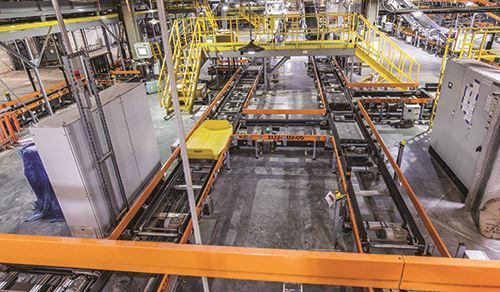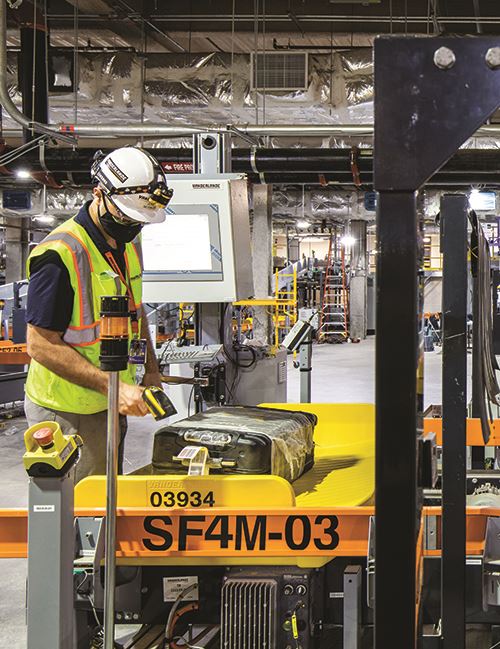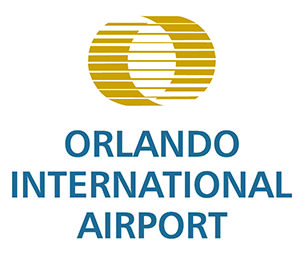The South Terminal Complex that Orlando International Airport (MCO) is scheduled to unveil this September will include several noteworthy features, including 100% facial recognition for international arrivals and departures, large-screen interactive digital media and the first fully integrated terminal in the U.S. for rail, air and ground transportation.
The South Terminal Complex that Orlando International Airport (MCO) is scheduled to unveil this September will include several noteworthy features, including 100% facial recognition for international arrivals and departures, large-screen interactive digital media and the first fully integrated terminal in the U.S. for rail, air and ground transportation.
 The entire $4.2 billion project is about enhancing customer service, and the Greater Orlando Aviation Authority considers baggage handling a key component. Reducing baggage delays, damage or losses will add to the terminal’s “wow customer service,” says Davin Ruohomaki, the Authority’s senior director of Construction and Engineering.
The entire $4.2 billion project is about enhancing customer service, and the Greater Orlando Aviation Authority considers baggage handling a key component. Reducing baggage delays, damage or losses will add to the terminal’s “wow customer service,” says Davin Ruohomaki, the Authority’s senior director of Construction and Engineering.
Although the new system for checked bags will be largely invisible to passengers, it is already turning heads within the industry as the second U.S. airport to use a TSA-approved individual carrier/tote system rather than a traditional belt system. And that’s not the only big difference.
|
Project: New Baggage Handling System Location: Orlando (FL) Int’l Airport Site: South Terminal Complex Airport Operator: Greater Orlando Aviation Authority Cost: $130 million Design: 9 months Engineering: 10 months Supply: 12 months Installation: 18 months Commissioning: 15 months Testing: 12 months South Terminal Concept Architect: Fentress South Terminal Architect of Record: HNTB South Terminal Construction: Hensel Phelps; Turner-Kiewet Construction Co. Baggage Handling System Design & Construction: Vanderlande Variable Frequency Drive Motors: Nord Baggage System Maintenance & Operation: Vanderlande Technology Consulting: JSM & Associates Owner’s Rep for Design & Construction Oversight: JSM & Associates System Features: Individual carriers/totes for each item; upper-level baggage claim area; storage facility for bags checked in early Key Benefits of Tote System: High-capacity, high-speed baggage handling; fewer mishandled bags; shorter connection times; low energy consumption; reduced noise; bag jams virtually eliminated; bag slides increase accuracy of makeup |
Passengers arriving at MCO’s new South Terminal C will retrieve their checked bags on the same level where they deplane. Project designers explain that this will not only be more convenient for travelers, it will also provide a pleasing welcome to the region thanks to skylight canopies and floor-to-ceiling windows in the bag claim area.
The key to transporting baggage from the ground level to the upper level where passengers arrive is a tote system with more vertical circulation than a traditional conveyor belt system. The bag tag on each checked item is synched at check-in to a radio frequency identification (RFID) chip embedded in the tote, providing 100% tracking of the tote and bag to significantly reducing the risk of lost or misrouted items.
Advanced Technology
When MCO officials were in the early stages of planning what they wanted in a new baggage system, their research took them to Germany’s Dusseldorf Airport. “If you’re going to buy something, you want to test drive it first,” explains Ruohomaki. “We took our CEO, COO and core team that knows baggage to talk to the user, look at the system, observe it and understand how it works.”
This first-hand look ultimately sealed the deal. “That’s when we knew it was reasonable and logical to be the flagship airport in the U.S. with a totally integrated system for the new terminal,” says Ruohomaki, noting that better operational efficiency, power reduction and sustainability aspects for LEED certification were convincing factors.
Blair Cox, vice president of Design at JSM & Associates, counseled the project team about the advantages of a tote-based system like the one at Dusseldorf Airport. Cox notes that traditional conveyor systems used in most U.S. airports are adaptations of systems designed to carry aggregate and other raw materials. “The technology was forced into a baggage handling environment and was not designed for the unique demands of an airport environment,” he explains. “It was never going to be able to do all the things that you would like a bags system to do.”
Conversely, tote technology was designed specifically for transporting baggage. As a result, it offers multiple benefits—most notably, 100% tracking, energy savings, faster conveyance, reduced labor and maintenance costs and lower total cost of ownership.
“MCO is all about customer service and how to make the passenger’s journey as joyful of a process, or as painless, as possible,” Cox adds. Because bags in the South Terminal have less distance to travel from aircraft to the inputs to the claim carousel, they will often arrive to the claim area before passengers.
Instead of relying heavily on tugs, the system efficiently pushes bags to four different areas out near the planes. The Aviation Authority’s goal was for 5.5 minutes of in-system time, with no bag taking longer than 15 minutes. But the system was consistently beating that target during tests in March. “We have the longest path of a bag to the bag system clocked at 4 minutes, 22 seconds,” Ruohomaki reports.
An “early bag” storage facility is another unique feature in the South Terminal. With room for up to 1,850 bags, it will allow departing passengers to check in and drop off their luggage and other checked items at the terminal as early as the airline will accept them. The new amenity will prove especially helpful for travelers flying in for cruises and passengers with long gaps of time between checking out of their hotels and catching evening flights. “This is a welcome convenience because they are then free to relax, shop and dine at MCO without their luggage,” Ruohomaki explains.

Operational Efficiencies
Vanderlande designed and constructed MCO’s new baggage handling system in close concert with development of the rest of the South Terminal. Ion Apezteguia, project director with Vanderlande, notes that airport officials selected the new tote-based system for its lean, space-optimizing configuration, as well as its reliability and enhanced ability to trace bags. The innovative system is also expected to save MCO operating costs and expenses associated with lost or delayed bags.
 Individual carrier systems like the one installed in the South Terminal are designed to bring uniformity to the baggage handling process and enable more reliable operations, higher speeds and greater throughput. Because each bag stays within the confines of its own carrier/tote throughout the handling process, the risk of damaged bags and disruption to the system is nearly eliminated, says Apezteguia.
Individual carrier systems like the one installed in the South Terminal are designed to bring uniformity to the baggage handling process and enable more reliable operations, higher speeds and greater throughput. Because each bag stays within the confines of its own carrier/tote throughout the handling process, the risk of damaged bags and disruption to the system is nearly eliminated, says Apezteguia.
Additionally, each tote is equipped with RFID technology, allowing bags to be tracked and located from check-in to departing aircraft, and from arriving aircraft to claim carousels. This means the rate of mishandled bags is very low, stresses Apezteguia. “We use scanners and cameras to make sure we know exactly where the luggage is every single moment,” he adds.
Without 100% tracking, bags are more prone to be misdirected and misplaced—adding time and cost to the handling process. Moreover, if multiple bags of unknown status arrive at a checked bag reconciliation area, more inspection space is required.
With MCO’s new system, cleared bags and alarmed bags can be mixed on the same line without risk of misrouting, because each bag is uniquely tracked with an RFID-enabled tote. That means, the system needs fewer bag inspection stations. “You give back real estate and you give back people, and it just makes for much more precise security profile and delivery of baggage,” Cox explains.

Handling systems that use totes consume significantly less power, he adds. Variable frequency drives from Nord are inherently more energy-efficient, and the conveyor automatically shuts down when it is not carrying a tote. “It only runs when it has the need to propel a bag, so the energy savings are dramatic,” says Cox.
The individual carrier/tote system in the new South Terminal is expected to be 45% more efficient than the traditional belt system at MCO’s North Terminal.
Tug operations are also reduced, saving maintenance and fuel costs, because bags are delivered much closer to the aircraft. “There’s an energy savings benefit that’s created by the way you change the operation,” Cox says.
In terms of installation and maintenance, he says the new belt system is superior to a traditional belt system. “For example, if you were to try to replace a belt on a regular conveyor, you’re probably looking at about an hour to an hour and a half of repair time,” he relates. “On this system, it’s five minutes—a dramatic difference.”

The frame of MCO’s new system requires less real estate because all of its motors are tucked underneath. “That allows a much thinner profile than most belt conveyors,” explains Cox.
Regarding overall cost, Cox notes that airports spend more to procure individual carrier/tote systems, but their total cost of ownership is less due to savings associated with energy consumption and maintenance. He estimates the break-even period at about 4.5 years.
Apezteguia notes that the South Terminal’s baggage handling system is highly flexible and expandable. “If they [MCO officials] want to expand to the north, south or west, we can expand without difficulty, because it’s just adding more conveyor and connecting it to the existing baggage handling system we’re installing right now.”

Given its high volume of leisure travelers, MCO opted to outfit the new baggage system with large 61-inch totes that can accommodate standard-sized and oversized items. This means that golf clubs, strollers and wheelchairs will arrive at the baggage carousel along with passengers’ other luggage. “We made a custom-made carrier that will become our standard for the future,” Apezteguia explains. “It is capable of carrying up to 98% of all of the luggage that goes through Orlando International.”

Construction
The Greater Orlando Aviation Authority structured the South Terminal baggage system project as a construction manager at risk contract, with Vanderlande serving as the design-build-operate-maintain (DBOM) contractor. “We had our architect take the concept and advance it at the same time as the DBOM initiated their design, and then we just overlayed them together,” Ruohomaki explains.
He estimates that having Vanderlande operate and maintain the system will save the airport about 50% in labor costs.
Construction required close collaboration with the team building the new South Terminal—not only to ensure that the baggage handling system would be appropriately accommodated, but that its installation would not interfere with or be impeded by other construction. “When we got the contract awarded, we started a lot of coordination to make sure everything would fit in the South Terminal, and made sure we created a right-of-way,” Apezteguia recalls. Installation began in mid-2019, and the system was undergoing TSA certification in early spring 2022.
Apezteguia stresses the importance of weekly coordination meetings with stakeholders to keep all aspects of the project on task. Despite the large number of entities involved throughout the project, he says the open-book, transparent way of working promoted by the Aviation Authority contributed to success.

Lessons Learned
Reflecting on the project thus far, Ruohomaki emphasizes the value of strategic planning. This paid off in spades regarding equipment procurement. Because Vanderlande purchased equipment for the project early and was able to store it in a recently renovated warehouse space at the airport, supply chain issues currently hampering other projects have not been an issue at MCO. Deemed essential, work on the baggage system and other South Terminal projects continued throughout the pandemic, with increased health and safety protocols.
Ruohomaki also stresses the importance of communication and teamwork, no matter how cliché it sounds. On that note, he says that TSA and the airport have tackled the learning curve associated with new baggage handling technology together. “We’ve modified some of their processes, and we’ve adapted some of ours,” he remarks. “It’s a true partnership.”
Editor’s Note: Stay tuned for details about the rest of MCO’s South Terminal Complex in our upcoming July/August 2022 issue.


 facts&figures
facts&figures

